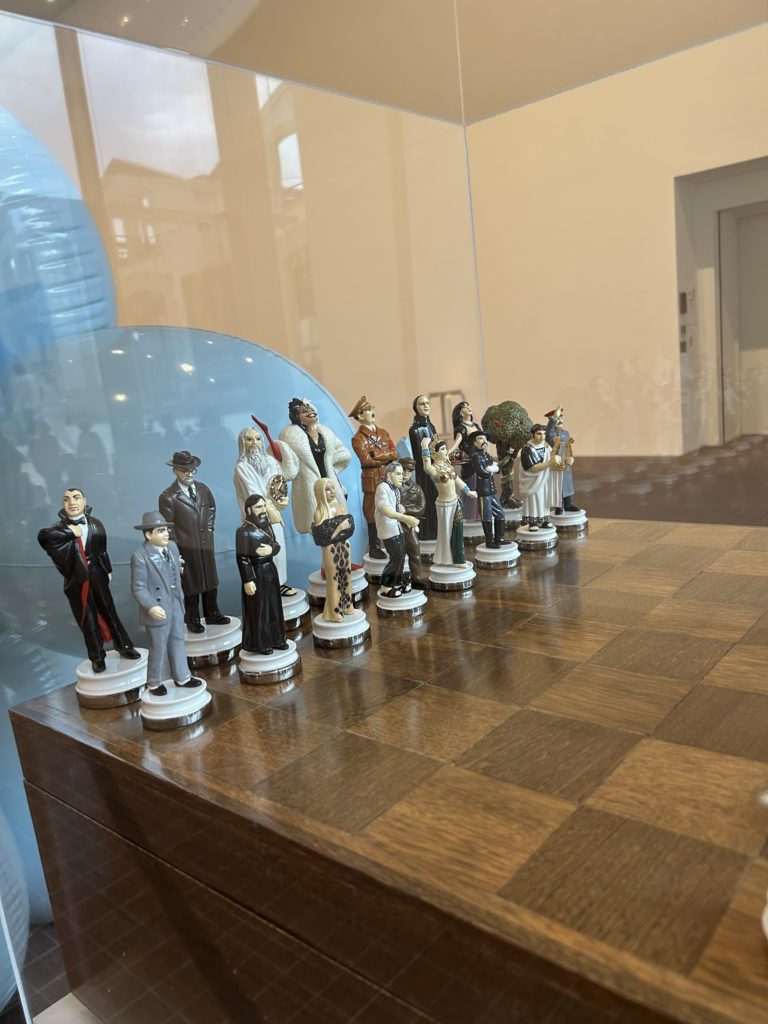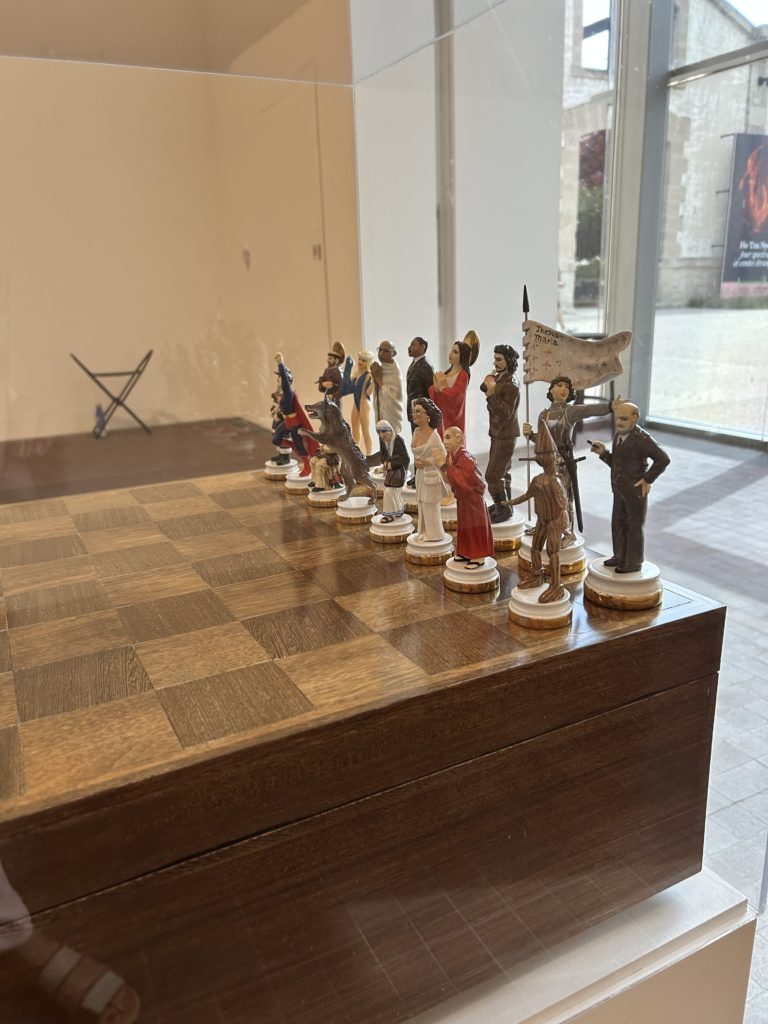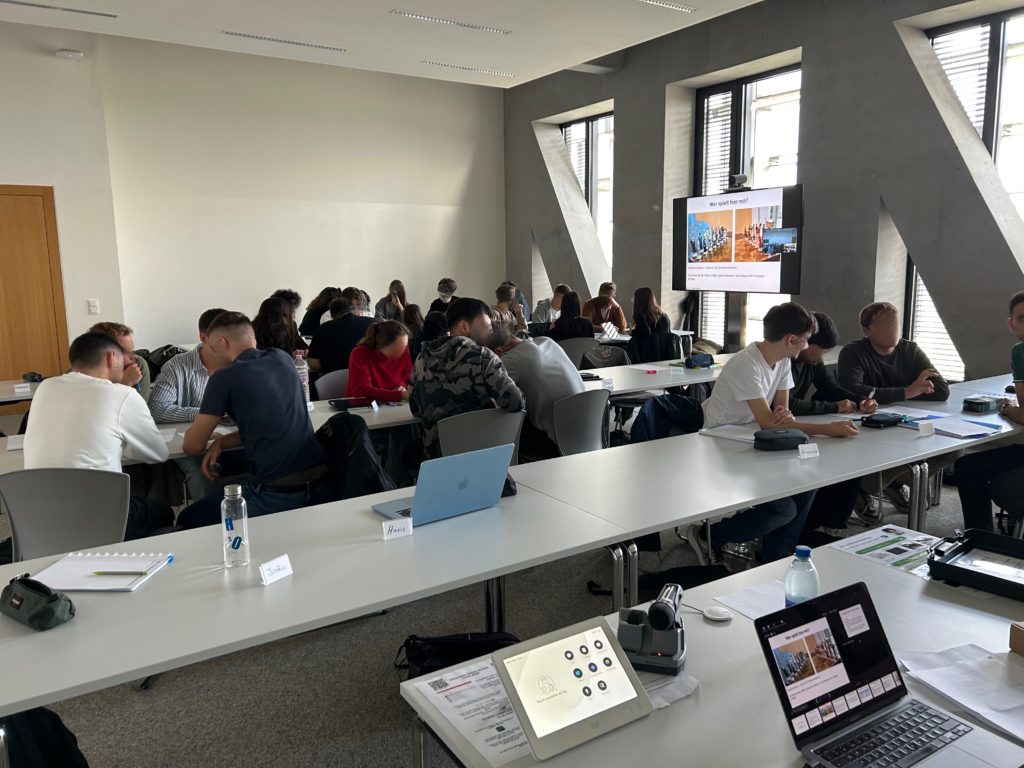Is history a battle between good and evil? A game of ideology? A question of perspective?

In the first session of our Public History seminar, we explored these questions using Maurizio Cattelan’s chessboard installation Good vs Evil – a surreal tableau of historical, religious, and fictional figures locked in symbolic combat.
Students were divided into six groups, each analyzing different aspects of the chessboard. The initial reactions were revealing: many students instinctively saw a “good side” and a “bad side.” But that distinction didn’t hold for long.
From Visual Analysis to Historical Interpretation
To guide their analysis, each group worked with tailored worksheets focusing on one thematic dimension: political figures, religion, ideology, representation, etc. The worksheets posed questions such as:
- Which figures do you recognize?
- What ideologies are represented – or excluded?
- What does this side of the chessboard suggest about power, memory, or morality?
At the heart of this exercise was a challenge:
Each group was asked to formulate a sentence completing this prompt:
“This chess game presents history as…”
This sentence wasn’t just a conclusion – it shaped how each group worked and sparked discussion around historical narratives, representation, and the ambiguity of moral categories.

Here’s what emerged:
- Group 1: “…a repeatable pattern.”
→ The group questioned why Lenin and the Wolf were on the “good” side. Is revolution always heroic? Is the predator a misunderstood symbol? - Group 2: “…a question of perspective on what is good or evil.”
→ They debated the placement of Chronos and Trotsky on the “evil” side. Why is time or radicalism framed as dangerous? - Group 3: “…a clash between ideologies – West vs. East.”
→ A striking comparison emerged: Cruella de Vil (who kills dogs) was compared to Hitler (who murdered Jews). The group also noted the absence of Jewish figures, highlighting how erasure shapes public memory. - Group 4: “…a battle over dominant religions.”
→ This group questioned why Lenin is considered “good” while Trotsky is not. They also emphasized that “evil” appears on both sides of the board – a deliberate ambiguity? - Group 5: “…a complex game between good and evil.”
→ Their discussion revolved around ambiguity: good and evil are not absolutes but fluid labels, depending on who tells the story. - Group 6: “…a Eurocentric narrative.”
→ The group pointed out the absence of the Persian cultural world and broader non-Western perspectives. Even a seemingly diverse board can reflect a narrow lens.
Theory Meets Practice
As students debated their interpretations, we connected their insights to key concepts in Public History:

- Shared Authority: Who decides what a figure represents?
- Free-Choice Learning: What happens when there are no captions or explanations?
- Problem-Posing Education (Paulo Freire): Can we use art to ask better questions, instead of rushing to answers?
- Reflective Practice: How do our own assumptions shape what we see?
What made this session powerful was not only the content of the discussion – but the way it unfolded.
By working together in groups, students were not passively taught these theoretical concepts.
They experienced them.
Through dialogue, disagreement, and reflection, they engaged empirically with the very foundations of a contemporary Public History approach.
A recurring insight across all groups was this:
Our understanding of history is shaped by what we already know – and by what we’ve never learned to question.
And Then Came the Banana
To wrap up, we looked at another of Cattelan’s provocative artworks: Comedian – a banana taped to a wall.
Sold for $120,000 at Art Basel Miami in 2019 and later shown at the Centre Pompidou-Metz in Dimanche sans fin (2025), the banana made headlines again when a visitor simply took it down and ate it.
“You’re not buying the banana. You’re buying the idea.”
– Galerie Perrotin
So – what is the idea?
Like the chessboard, the banana asks us to confront our assumptions:
What do we value as art? As history? As truth? Can artists like Cattelan be seen as public historians – provoking conversations about memory, identity, and meaning?
That’s what Public History is about
Not finding one answer – but opening many.
Dr. Marie-Paule Jungblut
Research and Development Specialist
University of Luxembourg
“Introduction to Public History” (1st Year BA History)